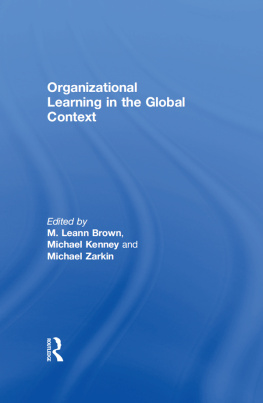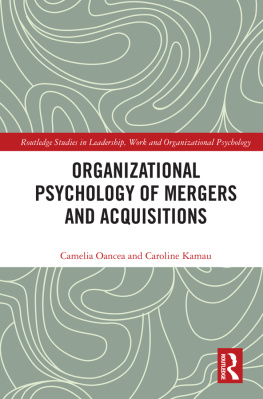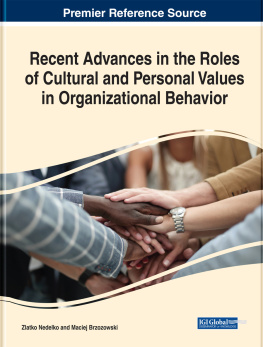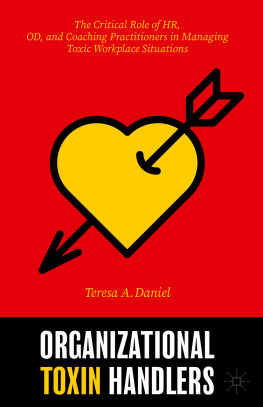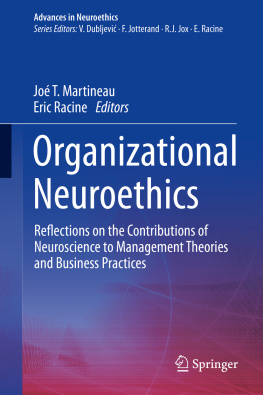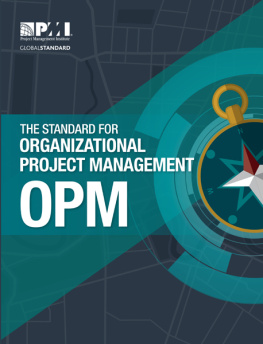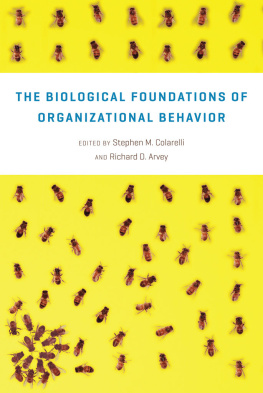CHAPTER 1
Organizations Behaving Badly: Using Destructive Organization Behaviors to Inform Corrective
Daniel J. Svyantek
Auburn University
This volume of Research in Organizational Sciences is titled, Organizations Behaving Badly: Destructive Behavior and Corrective Responses. This volumes history has been interesting. It is the interesting outcome of calls for papers for Research in Organizational Sciences. These calls asked for contributions to understanding organizational behavior and organizational theory through the use of historical and/or military examples. As the reader will see, the scope of this volume expanded based on the manuscripts received from these calls. This expansion of scope, however, has a common theme exhibited in all the chapters in this volume.
The common theme in the chapters in this volume is the interaction of person and organizational context. Each chapter in this volume deals with the issue of destructive behaviors that occur within organizations (e.g., unethical behavior directed internally or externally). Each chapter examines this behavior through the lens of a deceptively simple perspective on behavior proposed by Funder (2001, 2006). Funder proposed a model of behavior in which three factors are considered for understanding behavior: predicting behavior and drawing inferences about actors in situations. These three factors are (1) the actual behavior that a person may or may not perform in a situation; (2) the individual differences of actors within a situation; and (3) the context in which the behavior is occurring. For example, suppose you see an individual hitting another person. You need to consider the actual behaviorwas the hit violent and aggressive or done for protection? You need to consider the individual differences of the actorsare the actors of similar build and gender or are there physical differences among the actors? You need to consider the context of the behaviorare you watching a barroom brawl or are you watching a boxing match?
We draw different inferences about the nature of behavior and the nature of people based on these three factors. This simple model has two related constructs in the study of organizational behavior. These are the concepts of person-environment fit (Kristof, 1996) and the attraction-selection-fit model (Schneider, 1987a, 1987b).
Kristof (1996) describes two forms of fit with relevance for understanding organizational behavior. First, person-job (PJ) fit is concerned with the degree to which there is a match between an employees skills and abilities and the requirements of the job the employee holds. This form of fit is concerned with the ability of the individual in a job to perform the tasks necessary for the job. Second, person-organization (PO) fit is concerned with the degree to which there is a match between employee characteristics and the characteristics of the organization (e.g., organizational culture) in which the employee works. Here fit refers to the relationship between the individual actors values and characteristics and the organizations values and characteristics. For example, we will see some organizational contexts support particular behaviors (e.g., unethical behavior or self-serving behavior). Better fit implies the actor is more likely to perform the behavior supported by the organization than someone with less fit.
The attraction-selection-attrition model (Schneider, 1987a, 1987b) provides an important means of understanding of how organizational actors and organizational contexts come to parallel each other. According to Schneider (1987a) this is due to three main processes. First, it occurs because people are attracted to places that they prefer (attraction). People will seek out organizational environments in which they are comfortable being a member. Individuals who enjoy working in groups, for example, are drawn to organizations emphasizing teamwork. Second, organizations base hiring and selection practices, at least partially, on whether an individual being evaluated acts like successful organizational members. This is a decision of compatibility (selection). Third, if people are hired because of person-job fit and enter an environment that is not a fit for them in terms of person-organization fit they will tend to leave it (attrition).
Each of the chapters in this volume draw, at least in part, on these social and organizational concepts to describe the actions of organizational members in differing situations. The eight chapters in this volume all, in some way, strive to use these concepts to understand basic processes leading to potentially negative and destructive organizational behavior. In addition, each paper tries to provide organizational practitioners with new ideas for improving human resource practices in organizations that make these behaviors less likely.
Doerrs chapter outlines processes through which organizational newcomers learn what behaviors and perspectives are expected and desirable (versus those which are undesirable) within their work context. This chapter proposes that who newcomers learn their information from plays a chief role in what the newcomers learn. The aims of this chapter are to examine the means through which organizational culture and values perpetuate via socialization processes. This chapter demonstrates how and from whom newcomers may learn information, what techniques newcomers may use to seek information, and how assimilation encourages the continuance of preexisting norms and corporate culture across generations of organizational members.
Brown and Januarys chapter looks at the impact of military sexual trauma on commitment in the United States Military. This chapter describes how the sexual harassment and assault continues in the military despite the punishments and policies derived from the 1991 Tailhook incident. The authors note that since the Tailhook incident researchers and policy-makers have extensively studied and scrutinized the antecedents and consequences of military sexual harassment and assault. This chapter focuses on how sexual harassment and assault impacts organizational commitment in the United States militaryan environment where a strong commitment to the military is sought. Their chapter is particularly concerned with how the psychological contract established between the military and service members can be breached by events like military sexual trauma. Workplace sexual harassment and assault are major violations of a psychological contract, both in employer-employee and employee-employee relationships. There is often a written expectation that the workplace will remain free from harassment and assault. When sexual harassment or assault occurs, it constitutes a psychological contract breach in that what actually occurs does not meet the expectations understood by all parties. The result is a perceived lack of fit with the organization and potential workplace deviance or attrition of organizational members. The authors provide ways for organizations to both manage the organizational commitment of individuals to buffer them against such sexual harassment trauma along with ways for organizations to improve human resource practices to combat such sexual harassment behavior.
Svyanteks chapter uses the U.S. Navys response to the USS Stark and USS Vincennes incidents of the 1980s to explore how punishment is used to change specific behaviors of individuals within a particular job classification. During the 1980s in the Persian Gulf, there were several incidents threatening, or damaging, US naval ships (Arkin, 1989). First, the USS Stark was struck by two cruise missiles fired by an Iraqi jet on May 17, 1987. Second, the USS Samuel Roberts struck a mine. Third, the USS Vincennes shot down an Iran Air flight, killing 290 civilians, on July 3, 1988. These incidents have an underlying similarity. Each involves the captain of a U.S. naval ship making a decision to protect or not protect his vessel from incoming airplanes. Each captain faced uncertainty based on information being received and processed about approaching airplanes. These airplanes may or may not constitute a threat to each ship. The final decision in each situation required the captain to decide whether to fire missiles at the incoming airplanes and destroy the potential threat to each vessel. The chapter uses Funders three factors to explore how a specific behavior can be changed with punishment of an individual as a signal that past behaviors are no longer tolerated to others in the same job classification. This change is based on the effects of such punishment signals on an actors perception of what the context both no longer supports and what new behavior is supported. Moreover, the analysis of this situation shows that the negative behavior exhibited by the punished actor might be chosen by other organizational members in the same situation. The context must change to change the behavior. While not discussed in this chapter (the finished manuscript was received in February 2020), Svyanteks chapter helps understand some of the issues faced by police organization directly involved in the recent George Floyd and Rayshard Brooks killings by police in Minneapolis, MN and Atlanta, GA. Punishment of the police acting in these situations must be publicly sought by the justice system to signal to other individuals in the same jobs that these behaviors will not be tolerated. This punishment serves as a signal to not just the two police organizations involved: This message is being sent to all members of the police in the United States. However, the behavior(s) replacing such intolerable acts must be well defined and understood by the individuals in this job classification. Then proper training can be provided so that these behaviors do not occur again.
Next page

